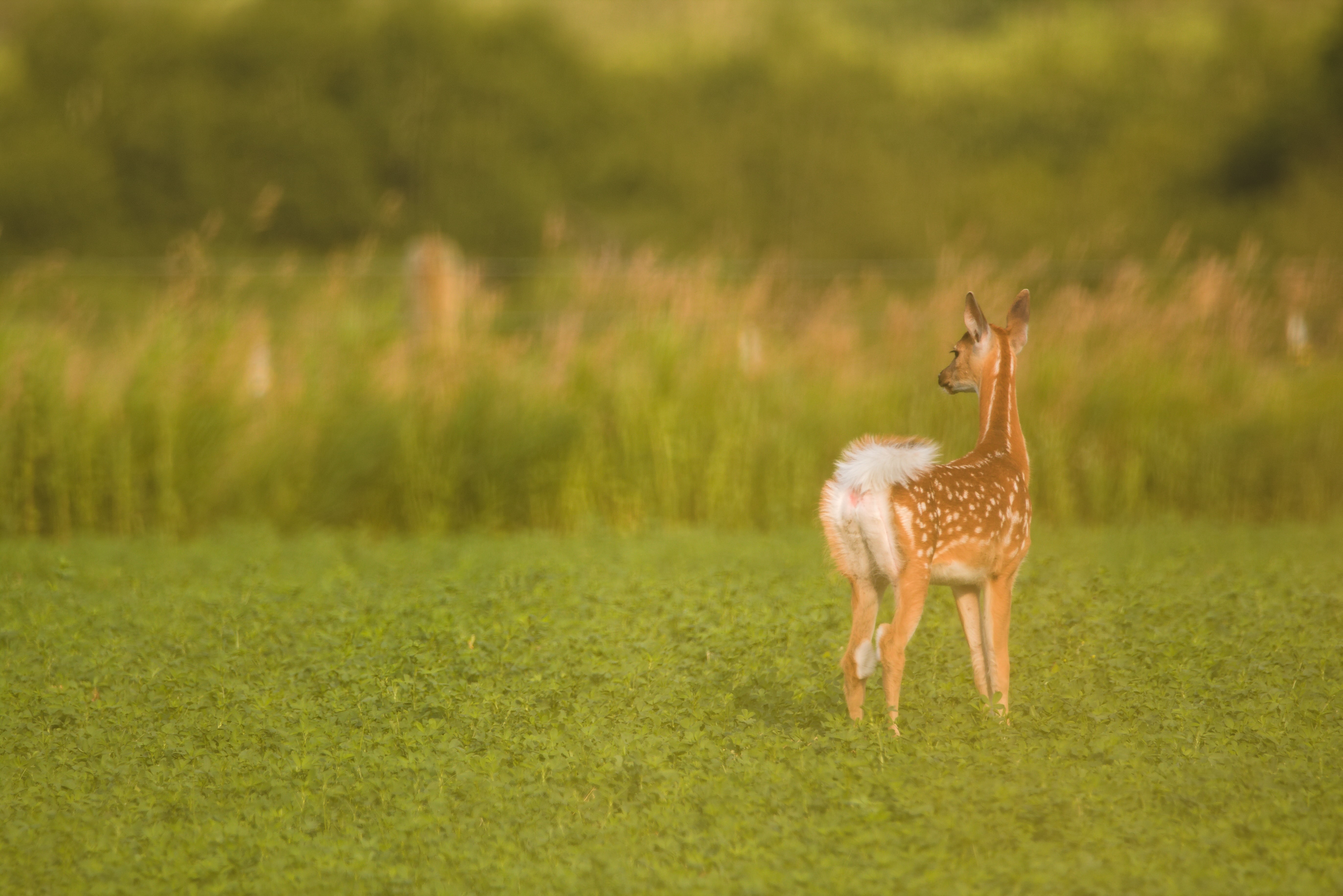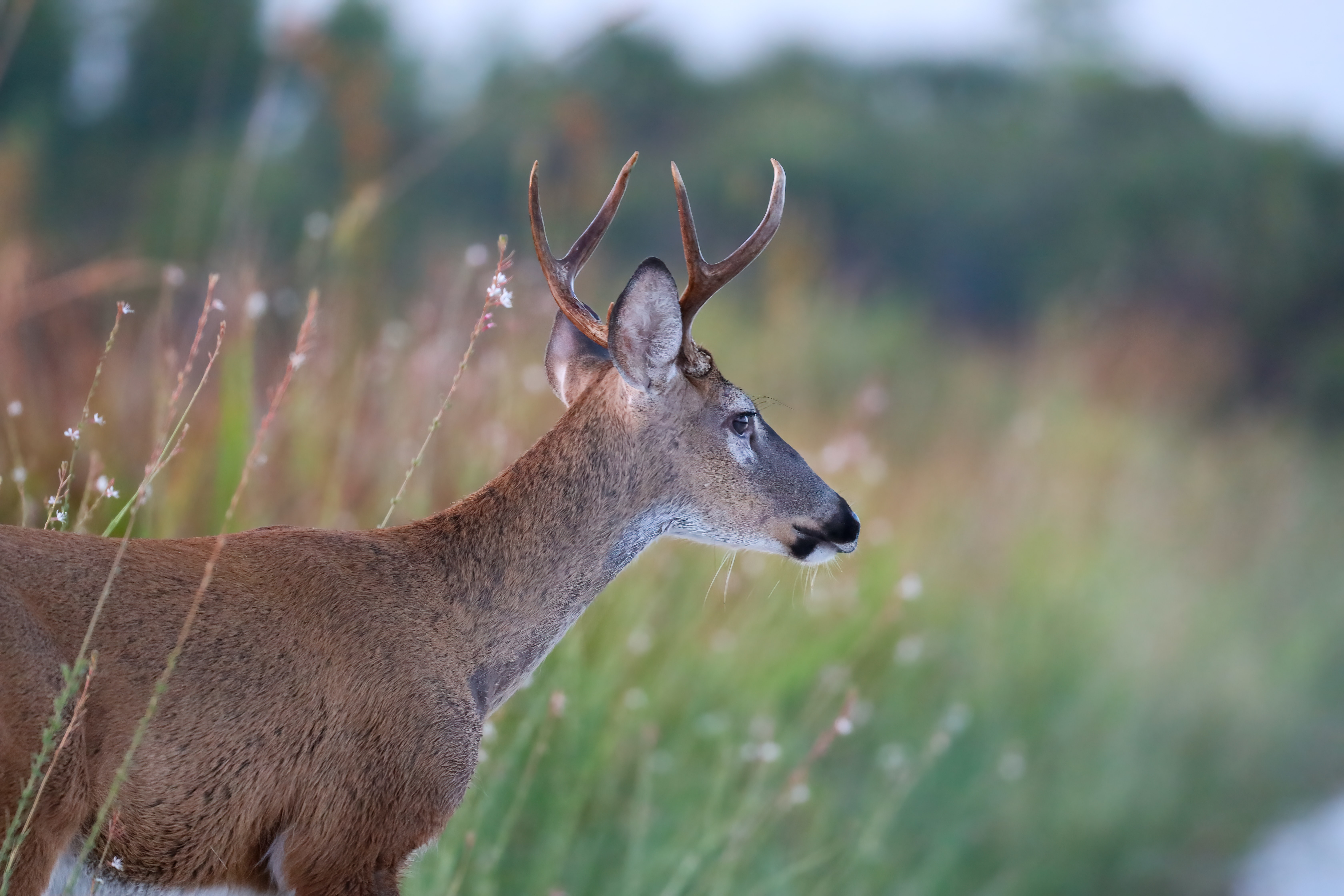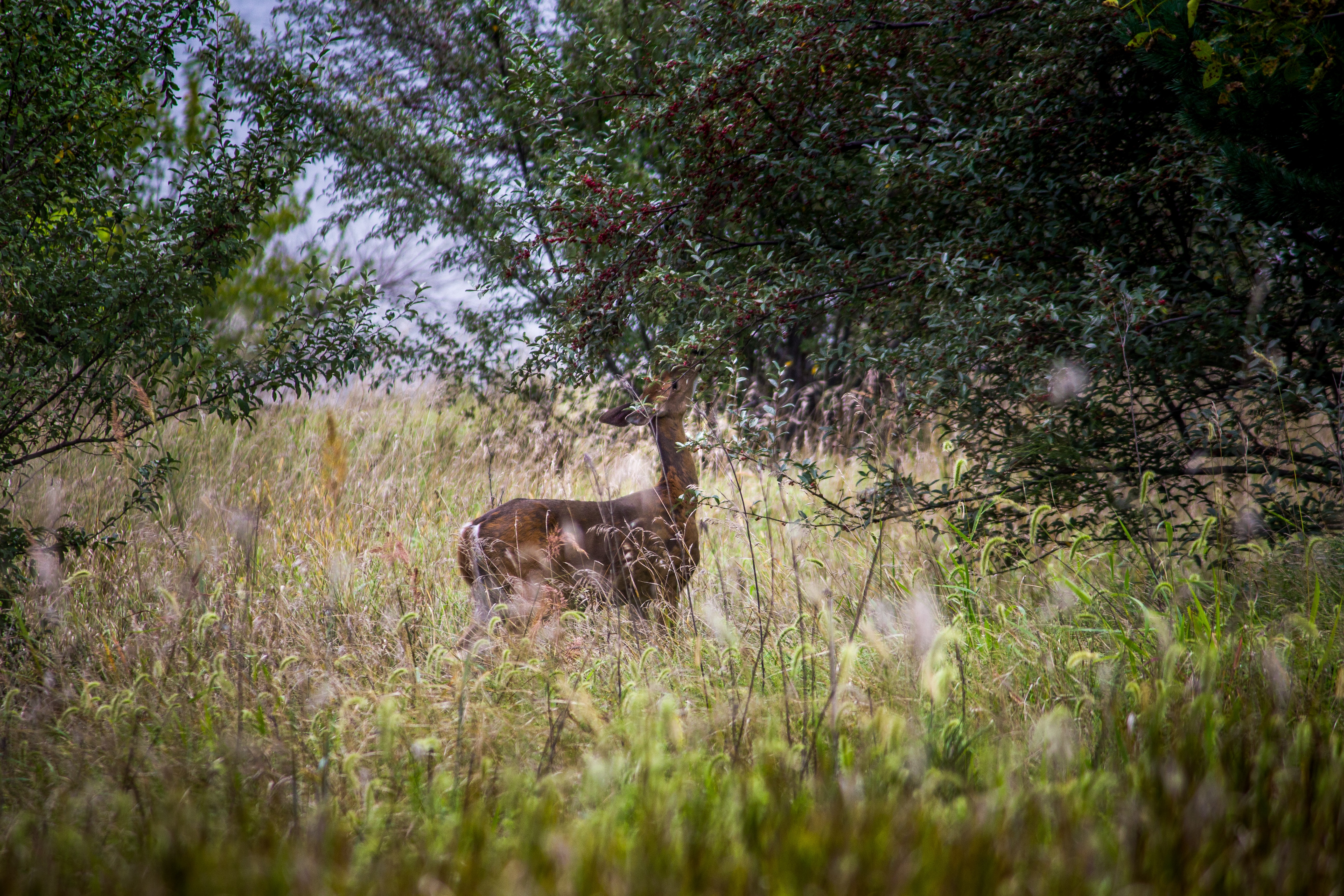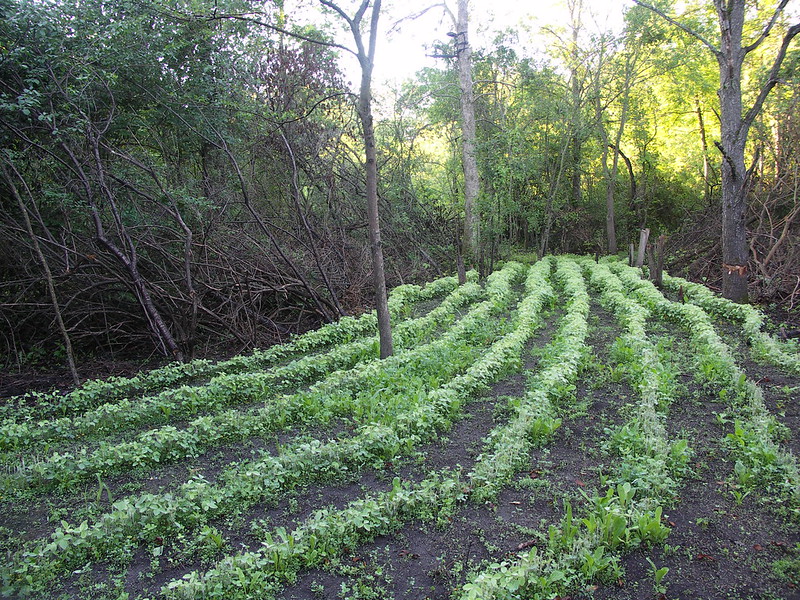Photo by HawgNSonsTV on Flickr
Hunters are increasingly adding food plots to their property or hunting areas to draw animals in and provide them with a nutritious year-round food source. They spend a great deal of time researching the best crops to grow, prepping the ground, and planting. Unfortunately, they often overlook the benefits of adding screening cover to the plot.
It’s easy to see that the value of a food plot is directly related to how safe and secure the deer feel when they come to feed. But deciding how to go about screening food plots can be confusing, so let’s talk about coverage options and factors you need to consider when developing a screening strategy!
What is a Food Plot Screening Cover?
In the simplest terms, a screening cover is a perimeter around the entire food plot, or parts of it, that act as a visual screen. You could consider it a border circling your plot with different characteristics than the food plot itself.
 Photo by Stephen Pedersen on Unsplash
Photo by Stephen Pedersen on Unsplash
Why is it Important to Add a Screening Cover to Your Food Plot?
A screening cover for your food plot serves different purposes, but its primary function is to create a privacy screen around the area. Within that primary function, there are a handful of different ways this is beneficial.
- A screening cover around the plot helps give the deer a feeling of security, encouraging daytime use. It’s amazing how deer are aware of their surroundings and if they can be seen from the road or a neighboring property.
- A screening cover forces bucks to come into the food plot when checking for does or other bucks instead of just glancing in from a neighboring field or the treeline.
- A screening cover keeps deer and other game hidden from potential poachers. People are less likely to trespass onto your property if they can’t see animals.
- A screening cover lowers social stress, creating separation between different deer as well as potential predators. This can help prevent large bucks from driving off smaller, less dominant males during the rut.
- A screening cover also conceals your hunting blind and your movement in and out of the blind. When coming and going, as you bump deer, you’ll see fewer and fewer animals on the food plot. They naturally seek out areas with low human pressure.
 Photo by STEPHEN SHEPPARD on Unsplash
Photo by STEPHEN SHEPPARD on Unsplash
Deciding on the Type of Screening Cover to Use
Fortunately, there are plenty of opportunistic ways to create what feels like a safe and private food plot for wild game.
Some of the most common screening cover options used are:
- Deer corn
- Egyptian wheat
- Sorghum sudangrass
- Taller varieties of Grain Sorghum
- Sunflowers (Predovik Black Sunflower)
- Small trees
- Brush
- Tall forbs
- Conifers
- Feather edging using existing vegetation
The different choices come with unique advantages and disadvantages, so weighing your options and thinking through each scene is critical. Some screens are expensive to construct, and some are considerably cheaper. Some screens take many seasons to grow and develop, and some may provide immediate results.
The best screen for you may ultimately come down to the option or combination of options that fits your wallet and timeframe the best.
Think About Screen Cover Resiliency
When deciding the material to use as a screening cover, it’s essential to consider how resilient and hardy the material is, especially if you are planting vegetation. Not only do you need something that gets tall enough and thick enough to shield the deer and any hunters, but you also need it to be resilient. The stems need to be stiff enough to hold up through the entire hunting season, which in many areas could include snowfall.
How Long Do You Want Screen Cover Establishment to Take?
Depending upon your choice of vegetation, you can have immediate cover, or it may take many years to establish. If you choose an option or options that take a long time to develop, you can always use some of the immediate options as a temporary cover.
Options for Immediate Food Plot Screening Cover
- Egyptian wheat is one of the most commonly used options when an immediate screening cover is wanted. It’s easy to grow, has high drought tolerance, grows to over 10’ tall on average soils, and has zero food value to deer.
- Sorghum sudangrass grows slightly shorter than Egyptian wheat but has sturdy one-half-inch stems. It isn’t highly favored by deer but does feed game birds once the heads drop in late fall. Excellent varieties include Photo 400 BRM Brand, Multicut 300 BMR Brand, Dry Stalk Brand, and Multicut 300 Brand.
- Hinge cuts are a favorite of property owners who want to keep costs low and don’t mind putting in their own time and effort. Hinge cutting is where you cut about halfway through a tree trunk and then push the top over. The tree stays alive but creates horizontal cover and may provide food for deer when the food plot isn’t growing.
- Earthen berms are a great option if your budget allows for it. These permanent fixtures need very little maintenance over time and provide consistent cover, unlike vegetation that may lose leaves or go dormant through the winter.
Options for Creating Mid-Range Food Plot Screening Cover
- Switchgrass such as Cave-N-Rock reaches desired screening height by the end of the second year if planted correctly. It provides a great buffer of dense, undesirable vegetation.
- Red, Jack, or Scotch pines are quick-growing and have low food values. These trees are the perfect complement to slower-growing varieties and provide year-round screening cover for your food plot.
- Speckled alders or hybrid poplars are quick-growing deciduous options that offer some forage options during fall and winter. Still, most trees lose their leaves early in deer seasons, providing little screening cover when needed.
Food Plot Screening Cover Options that Take a Long Time to Establish
- White or Norway spruce are solid choices in the Upper Midwest region and the Northeastern US. Norway spruce perform better in heavy soils with medium to full sun exposure. White spruce trees thrive in lighter soils, tolerate poor pH and low fertility, and grow in partial shade.
- Red cedar is commonly chosen as it tolerates really poor soils, provides fantastic bedding habitat,s and is largely ignored by deer except when other food sources are scarce.
Is the Screening Cover Well-Suited For Your Area?
When adding a screen to your plots, you must account for your local climate, especially in areas with harsh winter conditions. If you’re looking at perennial grasses, are they hardy enough to survive the winter in your growing zone? Also, consider if there is enough precipitation through the summer and fall to keep plants alive and green into the heart of the hunting season.
How Much Maintenance Will it Need?
When it comes to maintenance, you need to consider short-term and long-term upkeep.
- Annual grasses are often inexpensive, but you’ll need to replant every spring for adequate cover. Native perennial grasses will provide cover much longer.
- Trees and shrubs may need trimming as they grow to keep shooting lanes open, but this also means they create dense coverage. Grasses don’t require much in terms of seasonal maintenance, but as years go by, the stand can thin to a point it needs replanting.
How Deep Should Your Screen Be?
Another consideration is the depth of the screen. The ideal depth varies depending on location and setup, but a general rule of thumb is ten to fifteen yards. This depth typically provides a thick enough visual break that it blocks the view and lasts most of the season before it breaks down in late winter.
Remember that building a screen too wide may limit your shooting opportunities if your stand is not high enough to shoot over the top of the screen.
Should You Avoid Adding Food Crops to Your Screening Cover?
It is often debated whether or not you should use food crops in your screening cover. While they are usually readily available and make great options, you must consider the following.
- Why encourage deer to come towards the screen cover you hope to use to hide your route to and from the hunting blind or stand? If its purpose is to hide the deer within the plot and conceal your movements, you’re negating this when the deer are highly attracted to the screen itself.
- As deer feed on the screen, will it impact its integrity? You want your screen to stand up to the weather, so it doesn’t snap or bend, defeating its purpose. If you put attractive food crops in your screening cover, they may trample critical materials when trying to reach food.
On the other hand, it can be beneficial to add in some vegetation that is palatable but not as enticing as the food plot itself. While the plot is actively growing and thriving, animals will primarily eat that material. But in times of stress, and during the winter, components like brush or smaller trees can be used as a food source, commonly referred to as “browse.” An extra food option like this keeps game in the area instead of leaving to look elsewhere.
 Photo by Jeffrey Hamilton on Unsplash
Photo by Jeffrey Hamilton on Unsplash
Ready to Get Started?
Whether you’ve already established a food plot and need help with screening cover or are starting from the very beginning, we’re here to help! Deer Creek Seed has you covered, from our food plot guides to a host of wildlife seed products!
Additional Resources
- Not interested in planting vegetation? The experts over at the National Deer Association talk about using naturally occurring vegetation as a screening cover.
- Mossy Oak gives the rundown on why deer need to feel safe when grazing, and ways to go about creating visual screens for your food plots.
Interested in more information on short, mid and long-term screening covers? Whitetail Habitat Solutions goes more in depth about each type, and why a combination may be the best plan.



